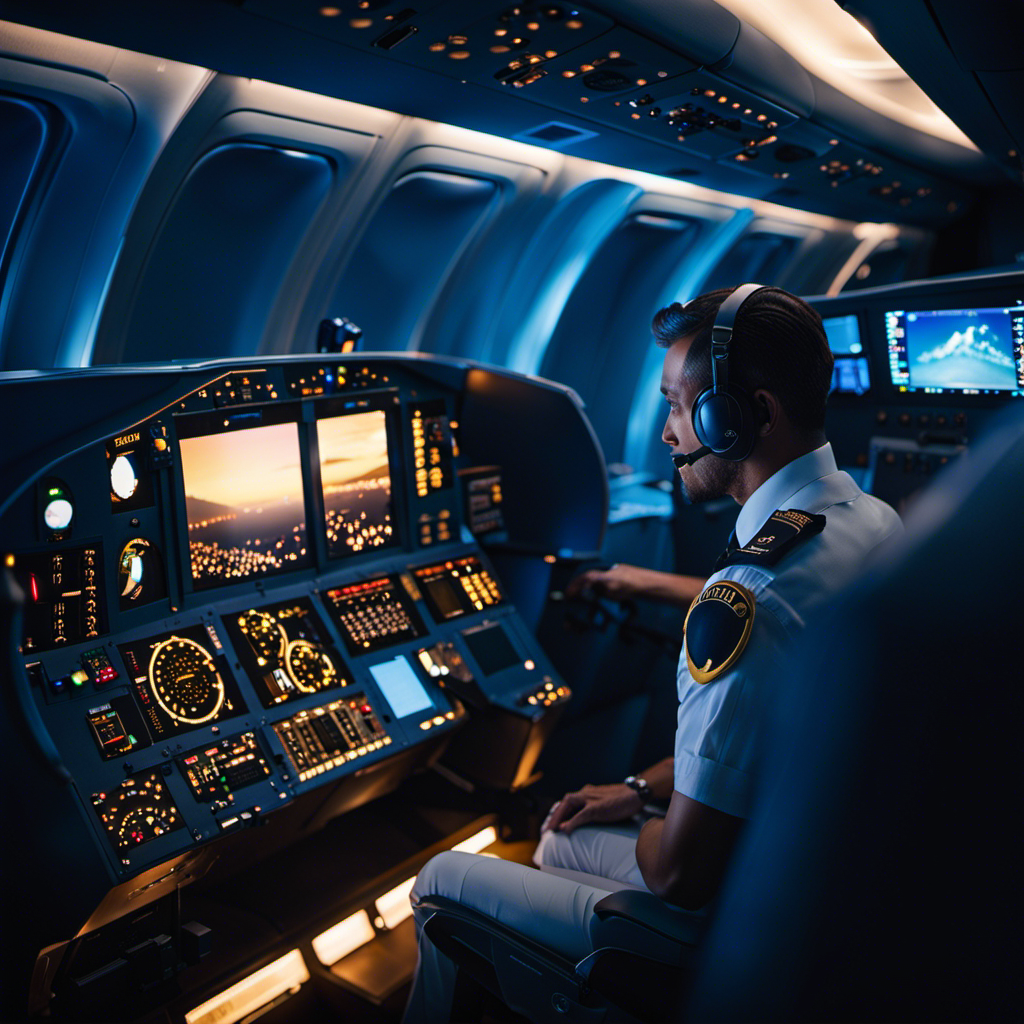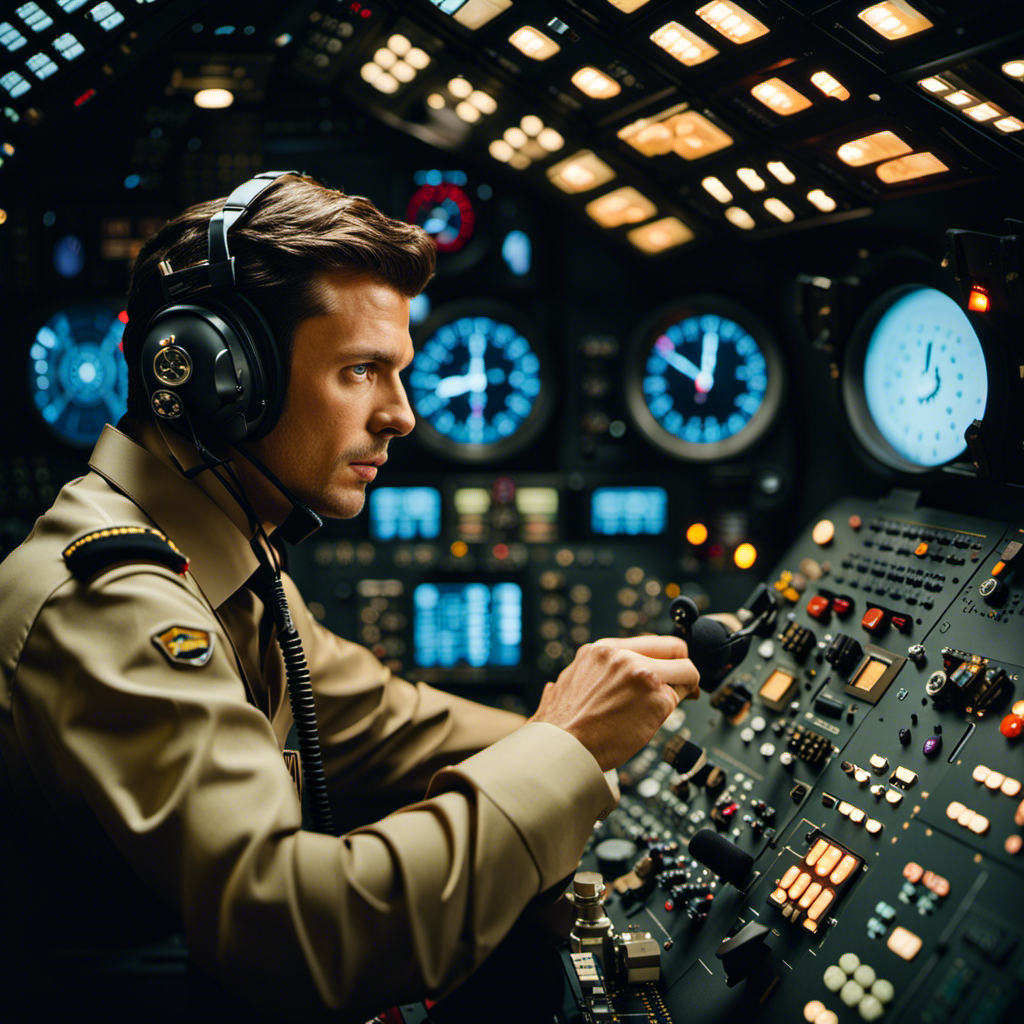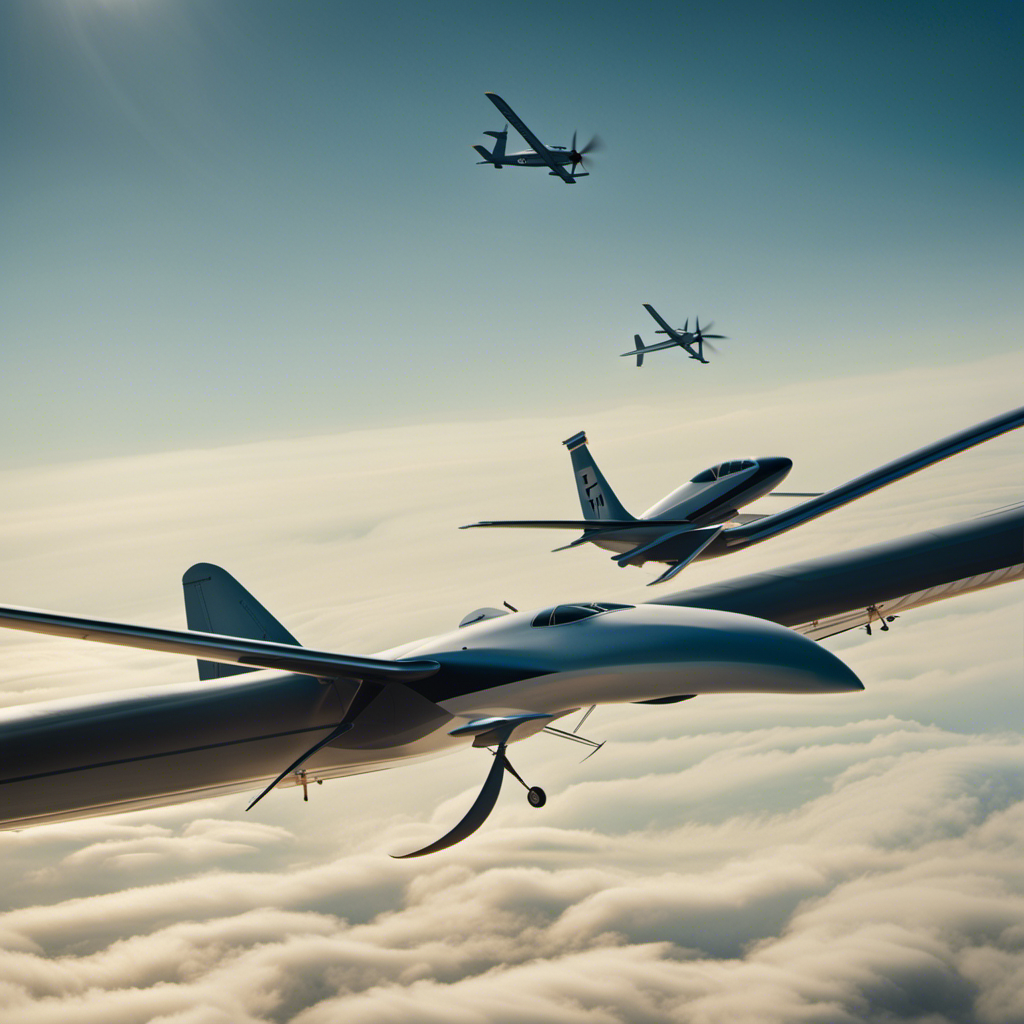As a pilot, I often fly through the vast blue skies on long-haul flights that can last up to 15 hours. You might be wondering – do pilots actually get some rest during these marathon journeys?
Well, let me shed some light on this fascinating topic. In this article, we will explore the importance of pilot rest on lengthy flights, delve into their work schedule, and uncover the truth about whether pilots catch some Z’s mid-flight.
So fasten your seatbelts and prepare for a journey of knowledge and discovery.
Key Takeaways
- Co-pilots actively monitor and manage fatigue during long flights.
- Pilots have designated rest periods and access to dedicated rest areas with sleeping facilities.
- Co-pilots play a crucial role in ensuring necessary breaks are taken and supporting each other’s well-being.
- The future of pilot rest and safety measures includes the use of wearable devices for real-time monitoring and advancements in cockpit automation and AI.
The Importance of Pilot Rest on Long-Haul Flights
You’ll be glad to know that getting enough rest is crucial for pilots on long-haul flights. Pilot sleep duration plays a vital role in ensuring the safety and well-being of both the crew and passengers. Sleep deprivation risks can lead to impaired cognitive function, decreased alertness, and increased likelihood of errors.
To mitigate these risks, pilots are required to adhere to strict rest regulations. Before a long-haul flight, pilots are required to have a minimum rest period of 10 hours, with at least 8 hours of uninterrupted sleep. During the flight, they are allowed to take controlled rest breaks to combat fatigue.
Understanding the pilots’ work schedule is essential to comprehend the importance of their rest and how it impacts their performance in the cockpit.
Understanding the Pilots’ Work Schedule
During those long flights, it’s important to understand the pilots’ work schedule. As pilots, we have a carefully planned and regulated system to ensure our rest and alertness throughout the flight. Here’s what you need to know about our work schedule:
-
Pilot sleep patterns: Before a long flight, we are required to have a minimum rest period to ensure we are well-rested. This includes both pre-flight rest and in-flight rest opportunities.
-
Pilot fatigue management: Throughout the flight, we have specific guidelines for managing our fatigue. This includes taking short breaks and rotating duties with our co-pilot to maintain optimal performance and alertness.
-
Controlled rest: One technique we use is the concept of controlled rest. This involves taking short naps during the flight, typically in a designated rest area, to combat fatigue without compromising safety.
Understanding these aspects of our work schedule ensures that we can effectively manage pilot fatigue and maintain the highest level of safety during those long flights.
Now let’s dive deeper into the concept of controlled rest.
The Concept of Controlled Rest
One technique we use to combat fatigue is the concept of controlled rest, where we take short naps during the flight. Pilot fatigue is a serious concern in the aviation industry, as it can impair our performance and decision-making abilities. Controlled rest allows us to recharge and maintain alertness throughout long flights.
During these rest periods, one pilot takes a short nap while the other remains awake and vigilant. This way, we can ensure that there is always a well-rested pilot in the cockpit. The controlled rest periods are carefully planned and coordinated, adhering to strict regulations and safety guidelines. This practice has proven to be effective in reducing the risk of fatigue-related incidents.
Now, let’s explore the role of the rest area on aircraft and how it supports our rest and recovery.
The Role of the Rest Area on Aircraft
In the rest area on the aircraft, you can find comfortable sleeping quarters that are designed to support your rest and recovery. These areas are specifically designated for crew members to take breaks and ensure they are well-rested during long flights. The role of the rest area is crucial in maintaining the safety and well-being of the pilots.
Here are some key points about the rest area:
- The sleeping quarters are equipped with cozy beds and blankets to provide a comfortable sleeping environment.
- The rest area is soundproofed to minimize noise disturbance and create a peaceful atmosphere for sleep.
- It is important for pilots to get an adequate amount of sleep during long flights, typically around 4-5 hours.
Now, let’s delve into the regulations and guidelines for pilot rest, which play a vital role in ensuring their alertness and readiness for flight.
Regulations and Guidelines for Pilot Rest
To ensure your alertness and readiness for flight, it’s important to familiarize yourself with the regulations and guidelines for pilot rest.
Pilot fatigue is a serious concern in aviation, as it can compromise safety and performance. Flight time limitations are set in place to mitigate the risk of fatigue-related incidents. These limitations specify the maximum amount of time a pilot can be on duty and the minimum amount of rest required between flights.
The Federal Aviation Administration (FAA) and other regulatory bodies have established these rules to ensure pilots have enough time for rest and recovery. By adhering to these regulations, pilots can better manage their fatigue levels and maintain a high level of alertness during flights.
Transitioning into the next section, let’s now explore how pilots manage fatigue during long flights.
How Pilots Manage Fatigue During Long Flights
During long flights, pilots commonly use strategies such as napping and stretching to manage fatigue. Pilot fatigue management is crucial for ensuring optimal performance and safety in the cockpit. Sleep deprivation can significantly impair a pilot’s cognitive abilities, reaction times, and decision-making skills. To combat these effects, pilots employ various techniques to stay alert and focused.
- Power naps: Taking short, 20-minute naps during designated rest periods can help alleviate fatigue and improve mental acuity.
- Physical activity: Pilots engage in stretching exercises and light physical activity to increase blood circulation and reduce muscle stiffness, combating the sedentary nature of long flights.
- Hydration and nutrition: Proper hydration and balanced meals are essential for maintaining energy levels and mental clarity throughout the flight.
By implementing these pilot fatigue management strategies, pilots can mitigate the negative effects of sleep deprivation and perform their duties effectively.
Transitioning into the subsequent section about ‘strategies for staying alert and focused,’ pilots also rely on additional techniques to ensure maximum vigilance in the cockpit.
Strategies for Staying Alert and Focused
Pilots can maintain alertness and focus by implementing various strategies. One effective strategy is to ensure proper rest before a flight. This includes getting enough sleep and avoiding any activities that can interfere with sleep quality.
During the flight, pilots can engage in activities that promote alertness, such as regular exercise and stretching. They can also make use of cockpit resources, like caffeine and snacks, to boost their energy levels. Additionally, pilots are trained to recognize the signs of fatigue and to take appropriate breaks when needed.
By following these strategies, pilots can stay alert and focused throughout their flights, ensuring the safety of everyone on board.
Speaking of safety and rest, let’s now discuss the important role that co-pilots play in ensuring these aspects.
The Role of Co-Pilots in Ensuring Safety and Rest
Co-pilots play a crucial role in ensuring the safety and rest of the flight crew. As a co-pilot, my primary responsibility is to assist the captain in operating the aircraft and maintaining a high level of situational awareness. Here are three key ways co-pilots contribute to the well-being of the flight crew:
- Monitoring the captain’s fatigue levels and alertness during long flights
- Assisting in performing critical tasks, such as navigation and communication
- Taking over control of the aircraft if the captain becomes too fatigued
Understanding the pilot’s sleep patterns and the impact of sleep deprivation on their performance is essential for effective co-pilot support. By actively monitoring and managing fatigue, co-pilots help maintain a safe and efficient operation.
However, there are common myths and misconceptions about pilot sleep that need to be addressed.
Common Myths and Misconceptions About Pilot Sleep
It’s important to debunk common myths and misconceptions about how pilots get enough rest during their flights.
One common myth is that pilots don’t need much rest because they have autopilot systems to do the work for them. In reality, pilots have strict regulations and guidelines in place to ensure they get adequate rest. They follow a specific work schedule that includes controlled rest periods.
During long flights, pilots can take turns resting in a dedicated rest area equipped with sleeping facilities. These safety measures are in place to combat fatigue and ensure pilots stay alert and focused during their flights.
Co-pilots also play a crucial role in monitoring each other’s fatigue levels and taking necessary breaks. By understanding the importance of rest and implementing safety measures, pilots can maintain their performance and ensure the safety of everyone on board.
Looking ahead, the future of pilot rest and safety measures will continue to evolve to address new challenges and advancements in aviation technology.
The Future of Pilot Rest and Safety Measures
Contrary to common myths and misconceptions, pilots do have designated rest periods on long-haul flights. However, as technology continues to advance, the future of pilot rest and safety measures looks promising.
With the increasing concern of sleep deprivation affecting pilot performance, aviation companies are investing in innovative solutions. The use of advanced technologies, such as wearable devices, could monitor and analyze a pilot’s sleep patterns in real-time. These devices would provide accurate information on sleep quality and alertness levels, enabling airlines to implement appropriate rest periods during flights.
Additionally, advancements in cockpit automation and artificial intelligence could further alleviate pilot fatigue by assuming certain responsibilities during long flights. As the industry strives to prioritize pilot well-being and passenger safety, future technology holds great potential in revolutionizing the way pilots rest and combat sleep deprivation.
Frequently Asked Questions
How do pilots manage fatigue during long flights?
Pilots manage fatigue during long flights by employing various strategies. These include adhering to strict rest requirements, taking short naps during flight breaks, practicing good sleep hygiene, and engaging in physical activities to stay alert.
What are the regulations and guidelines for pilot rest?
Pilot rest regulations and guidelines are crucial for fatigue management and maintaining alertness during long flights. Controlled rest is implemented, debunking pilot sleep myths and misconceptions. These measures ensure safe and efficient operations.
What is the role of controlled rest in pilot schedules?
Controlled rest plays an important role in pilot schedules. It allows pilots to take short naps during long flights, ensuring they are well-rested and alert. This helps maintain safety and minimize the risk of fatigue-related errors.
How do pilots stay alert and focused during long flights?
As a pilot, I employ various sleep strategies and in-flight alertness techniques to stay focused during long flights. These include controlled rest periods, strategic napping, and utilizing caffeine to enhance wakefulness.
What are some common myths and misconceptions about pilot sleep?
Common myths and misconceptions about pilot sleep include the belief that pilots sleep for the entire duration of a flight. In reality, pilot sleep duration is limited and the quality of sleep can be affected by various factors such as cabin noise and discomfort.
Conclusion
In conclusion, it is crucial for pilots to get adequate rest on long-haul flights to ensure the safety and well-being of everyone on board. Regulations and guidelines are in place to ensure that pilots have sufficient opportunities for controlled rest during these flights.
The rest area on aircraft plays a significant role in providing a comfortable and conducive environment for pilots to recharge. Despite common myths and misconceptions, pilot sleep is carefully managed to maintain alertness and focus throughout the flight.
As the future unfolds, we can expect further advancements in pilot rest and safety measures, akin to a well-oiled machine, ensuring smooth and secure journeys for all.
Orion, better known as “Jetstream,” is the voice that brings the stories of the skies to life. His fascination with aviation began at a young age, sparked by his father’s tales of flying and adventure. Orion’s journey into the world of gliding was serendipitous, and from the moment he took his first glider flight, he knew he had found his calling.










